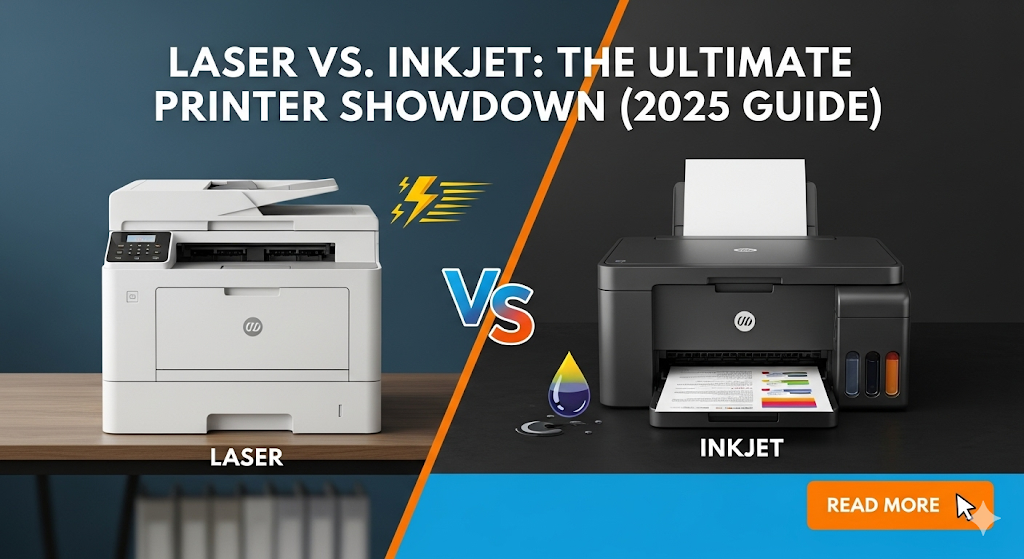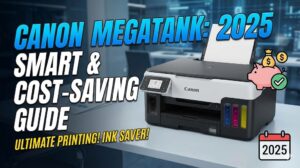Introduction
The debate between laser vs inkjet printers continues to puzzle buyers in 2025, with both technologies offering distinct advantages for different users. Understanding these differences can save you hundreds of dollars and prevent frustrating printing experiences.
Modern laser and inkjet printers have evolved significantly, with new features that blur traditional boundaries. However, fundamental differences in technology, cost, and performance remain crucial factors in your decision-making process.
This comprehensive comparison will help you choose between laser vs inkjet printers based on your specific needs, budget, and printing habits. You’ll discover which technology suits your home office, business, or personal use best.
What Are Laser vs Inkjet Printers?
Laser vs inkjet printers represent two completely different printing technologies with unique strengths and weaknesses. Understanding these core differences helps you make informed purchasing decisions.
Laser printers use electrostatic charges and heat to fuse toner powder onto paper. They excel at producing sharp text documents quickly and efficiently. Most laser printers are monochrome, though color laser models exist at higher price points.
Inkjet printers spray liquid ink droplets through tiny nozzles onto paper surfaces. They’re versatile machines capable of producing high-quality photos and colorful documents. Modern inkjet technology offers impressive resolution and color accuracy.
The choice between these technologies depends on factors like print volume, quality requirements, speed needs, and long-term costs. Neither technology is universally superior – each excels in specific situations.
Both printer types now offer wireless connectivity, mobile printing, and cloud integration features that weren’t available in earlier generations.
6 Key Factors to Compare Laser vs Inkjet Printers

Factor 1: Print Quality and Output
Laser printers deliver crisp, professional text that’s perfect for business documents, contracts, and reports. The toner creates consistent, smudge-resistant text that won’t fade over time. However, laser printers struggle with photo printing and gradual color transitions.
Inkjet printers excel at photo reproduction and colorful graphics. They can produce lab-quality prints on proper photo paper with smooth color gradations and fine detail. Text quality is good but may appear slightly less sharp than laser output.
Factor 2: Printing Speed and Efficiency
Laser printers significantly outperform inkjet models in speed, especially for text documents. Entry-level laser printers print 20-30 pages per minute, while business models reach 50+ pages per minute. They also warm up quickly after periods of inactivity.
Inkjet printers are considerably slower, typically printing 5-15 pages per minute for text documents. Photo printing is even slower, often taking several minutes per high-quality print. However, newer inkjet models have improved speed substantially.
Factor 3: Cost Analysis – Initial and Ongoing
Initial costs favor inkjet printers, with basic models starting under $50. Color laser printers begin around $200-300, while monochrome lasers start near $100-150.
Long-term costs tell a different story. Laser toner cartridges cost more upfront but print thousands of pages, resulting in lower per-page costs. Inkjet cartridges are cheaper initially but need frequent replacement, creating higher ongoing expenses.

Factor 4: Print Volume Capacity
Laser printers handle high-volume printing effortlessly without degrading performance or reliability. They’re designed for continuous operation and can print thousands of pages monthly without issues.
Inkjet printers work best for low to moderate print volumes. Heavy usage can cause print head clogs, increased maintenance needs, and reliability problems. Most consumer inkjets aren’t designed for continuous high-volume printing.
Factor 5: Maintenance Requirements
Laser printers require minimal maintenance beyond occasional toner replacement and cleaning. Toner doesn’t dry out during periods of non-use, making them ideal for infrequent printing.
Inkjet printers need regular use to prevent ink from drying in the print heads. Extended periods without printing can cause expensive clogs requiring professional cleaning or replacement parts.
Factor 6: Environmental Impact and Energy Use
Modern laser printers consume more energy during printing but use minimal power in standby mode. They generate some ozone and heat during operation but produce no liquid waste.
Inkjet printers use less energy overall but create more consumable waste through frequent cartridge replacements. However, many manufacturers now offer cartridge recycling programs to reduce environmental impact.

Advanced Features and Modern Innovations
Both laser vs inkjet printers now incorporate smart features that enhance user experience and productivity. Automatic document feeders, duplex printing, and large paper trays are standard on many models.
Wireless connectivity has become essential, with most printers supporting Wi-Fi, Wi-Fi Direct, and mobile printing protocols. Cloud printing services allow direct printing from Google Drive, Dropbox, and other online storage platforms.
Security features have improved significantly, especially for business-oriented models. User authentication, secure print release, and network encryption protect sensitive documents from unauthorized access.
Some manufacturers now offer subscription-based ink services that automatically deliver cartridges when supplies run low. According to Consumer Reports, these services can reduce printing costs by 20-50% for regular users.
Energy efficiency ratings help buyers choose environmentally friendly options that reduce electricity consumption and operating costs.
Common Mistakes When Choosing Between Laser vs Inkjet Printers
Ignoring Total Cost of Ownership: Many buyers focus only on printer purchase price, overlooking cartridge costs that often exceed the printer’s value within months. Always calculate per-page printing costs based on your expected usage.
Mismatching Technology to Usage Patterns: Choosing inkjet for high-volume text printing or laser for photo printing leads to poor results and wasted money. Match printer technology to your primary printing needs.
Overlooking Print Speed Requirements: Business users often underestimate the productivity impact of slow printing. If you regularly print multi-page documents, laser speed advantages justify higher initial costs.
Forgetting About Maintenance Needs: Inkjet printers require regular use to stay functional. Choosing inkjet for occasional printing often results in clogged print heads and expensive repairs.
Buying Outdated Models: Printer technology evolves rapidly. Older models may lack current wireless standards, mobile compatibility, or energy efficiency features you’ll want later.
Underestimating Space Requirements: Laser printers are typically larger and heavier than inkjet models. Ensure you have adequate space and proper ventilation before purchasing.
Consider future needs when making your decision. A printer suitable for current requirements might not meet growing demands or changing usage patterns.
Frequently Asked Questions
Q: Which is better for home office use – laser vs inkjet printers? A: For primarily text documents and moderate to high print volumes, laser printers offer better value and reliability. Choose inkjet if you need high-quality photo printing and have lower print volumes.
Q: How much can I save on printing costs with laser vs inkjet printers? A: Laser printers typically cost 2-5 cents per page for text, while inkjet costs range from 5-15 cents per page. For 1000 pages annually, laser saves $30-100 compared to inkjet.
Q: Do laser printers work well for color printing? A: Color laser printers produce excellent business graphics and presentations but can’t match inkjet photo quality. They’re ideal for colorful documents but not for high-quality photo reproduction.
Q: Which printer type lasts longer without use? A: Laser printers handle extended non-use periods better since toner doesn’t dry out. Inkjet printers may develop clogs if unused for weeks or months, requiring maintenance or cartridge replacement.
Q: Are there hybrid options combining laser and inkjet benefits? A: Some manufacturers offer tank-based inkjet printers with lower per-page costs, bridging the gap between technologies. However, no true hybrid combining both technologies exists currently.
Conclusion
The laser vs inkjet printers debate ultimately comes down to matching technology to your specific needs and usage patterns. Laser printers excel for high-volume text printing, office environments, and users prioritizing speed and low per-page costs.
Inkjet printers remain the best choice for photo printing, low-volume mixed printing, and users with limited budgets for initial purchase. Modern inkjet models have improved significantly in speed and efficiency.
Consider your primary printing tasks, monthly volume, space constraints, and long-term costs when choosing between laser vs inkjet printers. Both technologies continue evolving, offering better features and value each year.
The right choice depends entirely on your unique situation, but understanding these key differences ensures you’ll select a printer that serves you well for years to come.
Printer Buying Guide: Ultimate Guide to Choose Perfect Printer 2025 Read More.




